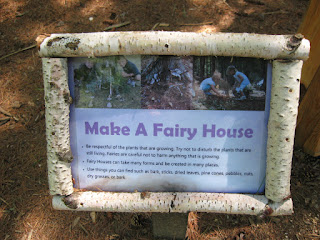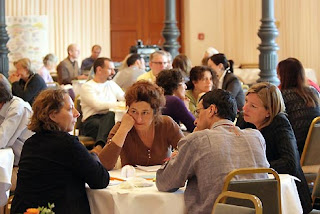Bookworm Gardens is not the storybook garden you might imagine with oversize teacups, fairytale castles, and a theme-park feel. Instead Bookworm Gardens is stories remembered and imagined from childhood found, in woods, fields, and sunny glades, and made fresh and vivid with plantings.
Located on eight acres of land made available by Sheboygan County in eastern Wisconsin, Bookworm Gardens is the dream of founder Sandy Livermore. It has grown through the commitment and generosity of volunteers, artists, community organizations, and businesses.
 |
| Peter Rabbit's hiding place, the tool shed in Mr McGregor's garden |
Children’s books, stories, and a few fairy tales certainly represent the majority, but the stories are for a wide range of ages, including adult. In addition to expected stories like The Tale of Peter Rabbit (Beatrix Potter) and Make Way for Ducklings (Robert McKloskey) for younger children, there are chapter books like Sarah Plain and Tall (Patricia McLachlan) and The Wind in the Willows (Kenneth Grahame). A Sand County Almanac (Aldo Leopold) is more familiar to adults.
Stories are told in big and small ways, but never in the same way. They sometimes spread out like The Magic School Bus (Joanna Cole) and are planted incidentally as tree sculpture of re-used materials inspired by The Tin Forest (Helen Ward). The Gardens are punctuated by several major elements, a Hansel and Gretel House, an amphitheater and, soon, an outdoor kitchen. Landscape architect Herb Schaal from EDAW (Fort Collins, CO) provided the design that brought together the stories, the landscape, gardens, and activities.
Open this spring for its first full season, Bookworm Gardens looks as if it’s been there longer. The landscape has worked with the stories to inspire the gardens. Attention has been paid to working with many of the existing plants. For instance, instead of clearing the land, they removed invasive species and dead wood, cleared selectively, and kept many of the the Red Pines. Following the land’s contours and features, the ravines and slope have been incorporated into the landscape design and stories. The small post-and-beam barn, a project by students at the local community college, uses weathered boards that make it look like it’s seen many hard Wisconsin winters.
Of the many things Bookworm Gardens has done well, one is to seamlessly bring together a love of stories, the power of place and setting, and the possibilities of gardens.
The Power of Place
 |
| The Magic School Bus lands at Bookworm Gardens |
Stories are told–or perhaps told better– at Bookworm Gardens because they are told through outdoor settings that are multi-sensory and fully dimensional, complete with weather and smells. Even the most brilliant illustrations and even pop-up books can’t provide sunshine, wind, a drop of rain, or a splash in the pond.
A carefully edited landscape gives a strong sense of place to all the stories with a changing feel from on story setting to another. The Magic School Bus, with wings extended, back doors flung open, and plants spilling out, looks very much as if Ms. Frizzle has been at the wheel and driven off the road. Positioning the bus heading down a small slope adds excitement.
 |
| Stopping by the Little House in the Big Woods. |
Follow a soft pine needle pathway to a small clearing under the Red Pines. It’s Laura Ingalls Wilder’s Little House in the Big Woods. At any moment, it seems, Pa could come around from the back of the covered wagon, Ma could come out of the small cabin to cook over the open fire and Laura and Mary might return from gathering wood. Anyone can put on an apron, sweep out the cabin, or play with corn-husk dolls and join Laura and her family in their story.
As unexpectedly as Jack and Annie come upon the tree house in Frog Creek, visiting bookworms come upon The Magic Treehouse (Mary Pope Osborne). Cantilevered over the ravine, hovering above the tree branches, the tree house gives a great sense of being up high along with an expansive view into the deep woods. As in the book, this treehouse is on pathways to adventures. In the quiet of the woods beyond sits a Japanese teahouse and garden. Step inside to fold paper cranes as in Sadako and the Thousand Paper Cranes (Eleanor Coerr) or count along with One Leaf Rides The Wind (Celeste Davidson Mannis). Over in the meadow, join Marco and imagine the fish to be caught from the bridge in McElligot’s Pool (Dr. Seuss). And keep an out for the family of ducks waddling right out of Make Way For Ducklings (Robert McCloskey), baby ducklings with wings out in a row behind mother duck to the stream’s edge.
Discoveries Everywhere
Like a really good book, the story gardens scattered across the landscape captivate readers, walker, gardeners, and bookworms. Opportunities for discovery are everywhere along meandering pathways, views that open, and thoughtful attention to materials and detail.
Rewards for noticing and looking closely are many and wonderful. They are to be commented on, puzzled over, and remembered. A slice has been taken out of the pizza garden from Curious George and the Pizza (Margaret and H.A. Rey). Charlotte’s message from Charlotte’s Web (E.B. White) is written in the spider web in the barn and is a creation of a local metal artist.
Look up. Cloudy With a Chance of Meatballs (Judi Barrett) has inspired hanging fishing bobbers, hotdogs, and hamburgers from overhead tree branches. Look down. Foot-high toadstools carved from fallen oak trees by a local friend of the garden pop-up here-and-there. For many they are fairy gardens located near tiny shelves of colored pebbles, nuts, pine cones, and bark. For others their specific profiles identify the type of mushrooms. No, look low. There's Stuart Little (E.B. White), his house and car, and miniature plants, tucked among the terrace near the ampitheater.
 |
| Where Winnie the Pooh lives under the name of Sanders |
Some smaller story gardens might be missed which would be too bad. The charming detail of Winnie The Pooh living under the name of Sanders is playfully presented in the tree house. Mr. Sanders’ cottage looks just like it does in the line drawing in Winnie The Pooh (A.A. Milne) except that the lines have been filled in and the cottage is child-size. Elsewhere, plants may nearly hide the story; by the end of the summer, the corn plants cover the cereal bowl and spoon of From Corn to Cereal (Roberta Basel).
Artists have brought a hand to creating sculptures, murals, embellishments. Beautifully crafted doors open the book bins in the stone pillars throughout the gardens, literally opening up more stories. And while not exactly a garden, a discovery is to be made in the girls’ restroom where a long-necked giraffe peeks over from one stall to next.
So well sited are the stories, you can go from story garden to story garden and discover a dozen stories before lunch.
So well sited are the stories, you can go from story garden to story garden and discover a dozen stories before lunch.
Layers of Stories, Gardens, and Play
 |
| Stories in the gardens |
Bookworm Gardens is a naturally inter-generational place. Grandparents stroll, sit, and bring a practiced green thumb to the garden. Children hop into a story and act it out or pick up the magnifying glass and look at flowers. Parents too move across a range of roles and activities: as player, walker, or reader, facilitating engagement for the youngest, or chatting with other parents and grandparents. Even youth are involved as readers in the garden.
 |
| Harry the Dirty Dog gets scrubbed |
Plantings add interest, content, and activities for children and adults. Children fill watering cans and water plants or, sometimes, a topiary llama or bear. In the grass they find the spiny green burrs of the rare American Chestnuts planted years ago on the property. Learning about what plants support caterpillars and attract butterflies in the Waiting for Wings (Lois Ehlert) butterfly garden is interesting to all ages. The garden around Is Your Mama A Llama? (Deborah Guarino) has a humorous collection of plants with animal names.
Places to sit, rest, remember, and retell the stories are plentiful, playful, and garden and story inspired. There are garden benches, a sod sofa, and rocking chairs. The Three Bears family of chairs might be too big or too small, but are often just right for lap time, reading time, and friend time.
Many Happy Endings
Bookworm Gardens is a wonderful story with many happy endings. It continues to grow. About 60 of the 75 story gardens have been planted and more are planned. The dinosaur for Dinosaur Bones (Bob Barner) had just arrived but was not yet planted when I visited. Next to the Hansel and Gretel House, land is being cleared and readied for The Secret Garden (Frances Hodgson Burnett). Closing for the winter in November, Bookworm Gardens will open next spring for a new season.
 |
| A soon to be planted story garden: Dinosaur Bones |








